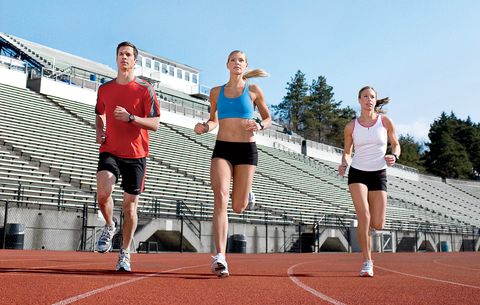
Critical Velocity (CV) has become an increasingly popular training pace in the running community over the last few years. So what is CV, and how can you use it to improve your running?
Tom Schwartz, PhD, aka Tinman, says CV pace is roughly equivalent to half-hour race pace. Some runners might refer to it as 10K pace, but Schwartz says that’s incorrect because most runners can’t run a 10K in a half hour. There are a couple ways to find your CV pace. The simplest is to use Schwartz’s online calculator, or you can determine your VO2max then calculate 90 percent of it.
Why and how does CV work?
There are different types of muscle fibers in the human body, commonly referred to as slow-twitch (type-1) and fast-twitch (type-2).
“[Type-1 muscle fibers] don’t have a lot of power but they have a lot of natural endurance,” Schwartz says. “They’re the kinds of muscle fibers that we use for postural maintenance, being upright… easy continuous long distance running, cycling, swimming, and so on.”
So, you can get pretty good at running by sticking to easy distance runs. You’ll work on aerobic fitness—about 60 to 75 percent of your VO2 max—as well as your type-1 muscle fibers. But if you want to see bigger improvements, you have to improve type-2 muscle fibers.
Type-2 muscle fibers are broken down into 2a and 2x. Type-2x muscle fibers activate when sprinting or performing very explosive, powerful movements. Type-2a muscle fibers activate when running intermediate paces between aerobic running and sprinting.
For a long time, lactate threshold pace, also known as anaerobic threshold, was considered the holy grail for endurance training. The more often you work at that pace—which is 80 to 83 percent of VO2 max for most avid runners, according to Schwartz—the higher your lactate threshold becomes over time, thereby improving your ability to sustain a fast pace without having to slow.
Schwartz wasn’t convinced: “The question I always had is: is running at lactate threshold the best way to improve the lactate threshold pace?” His answer? Critical velocity—90 percent of your VO2 max—is better.
By training at CV pace, he says, you become fatigue-resistant. Your heart pumps more blood, red blood cell count increases, many capillaries develop and surround your type-2a muscle fibers, and you create more mitochondria, which process oxygen.
“Your fast intermediate muscle fibers are so good now at using the available oxygen and not generating fatigue that you can go faster longer,” Schwartz says.
By Chris Hatler Published: Mar 11, 2022
Contact Coach Dempster Jackson to learn more about CV pace and how to incorporate it into your training.